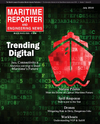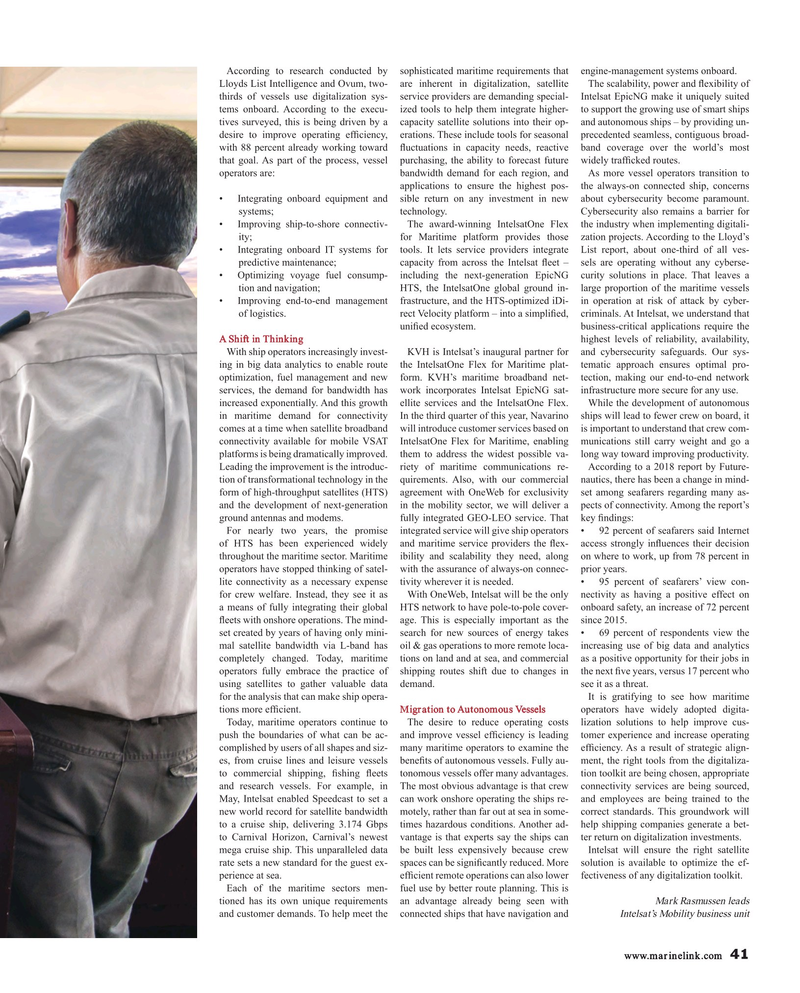
Page 41: of Maritime Reporter Magazine (July 2018)
Marine Communications Edition
Read this page in Pdf, Flash or Html5 edition of July 2018 Maritime Reporter Magazine
According to research conducted by sophisticated maritime requirements that engine-management systems onboard.
Lloyds List Intelligence and Ovum, two- are inherent in digitalization, satellite The scalability, power and ? exibility of thirds of vessels use digitalization sys- service providers are demanding special- Intelsat EpicNG make it uniquely suited tems onboard. According to the execu- ized tools to help them integrate higher- to support the growing use of smart ships tives surveyed, this is being driven by a capacity satellite solutions into their op- and autonomous ships – by providing un- desire to improve operating ef? ciency, erations. These include tools for seasonal precedented seamless, contiguous broad- with 88 percent already working toward ? uctuations in capacity needs, reactive band coverage over the world’s most that goal. As part of the process, vessel purchasing, the ability to forecast future widely traf? cked routes.
operators are: bandwidth demand for each region, and As more vessel operators transition to applications to ensure the highest pos- the always-on connected ship, concerns • Integrating onboard equipment and sible return on any investment in new about cybersecurity become paramount. systems; technology. Cybersecurity also remains a barrier for • Improving ship-to-shore connectiv- The award-winning IntelsatOne Flex the industry when implementing digitali- ity; for Maritime platform provides those zation projects. According to the Lloyd’s • Integrating onboard IT systems for tools. It lets service providers integrate List report, about one-third of all ves- predictive maintenance; capacity from across the Intelsat ? eet – sels are operating without any cyberse- • Optimizing voyage fuel consump- including the next-generation EpicNG curity solutions in place. That leaves a tion and navigation; HTS, the IntelsatOne global ground in- large proportion of the maritime vessels • Improving end-to-end management frastructure, and the HTS-optimized iDi- in operation at risk of attack by cyber- of logistics. rect Velocity platform – into a simpli? ed, criminals. At Intelsat, we understand that uni? ed ecosystem. business-critical applications require the
A Shift in Thinking highest levels of reliability, availability,
With ship operators increasingly invest- KVH is Intelsat’s inaugural partner for and cybersecurity safeguards. Our sys- ing in big data analytics to enable route the IntelsatOne Flex for Maritime plat- tematic approach ensures optimal pro- optimization, fuel management and new form. KVH’s maritime broadband net- tection, making our end-to-end network services, the demand for bandwidth has work incorporates Intelsat EpicNG sat- infrastructure more secure for any use.
increased exponentially. And this growth ellite services and the IntelsatOne Flex. While the development of autonomous in maritime demand for connectivity In the third quarter of this year, Navarino ships will lead to fewer crew on board, it comes at a time when satellite broadband will introduce customer services based on is important to understand that crew com- connectivity available for mobile VSAT IntelsatOne Flex for Maritime, enabling munications still carry weight and go a platforms is being dramatically improved. them to address the widest possible va- long way toward improving productivity.
Leading the improvement is the introduc- riety of maritime communications re- According to a 2018 report by Future- tion of transformational technology in the quirements. Also, with our commercial nautics, there has been a change in mind- form of high-throughput satellites (HTS) agreement with OneWeb for exclusivity set among seafarers regarding many as- and the development of next-generation in the mobility sector, we will deliver a pects of connectivity. Among the report’s ground antennas and modems. fully integrated GEO-LEO service. That key ? ndings:
For nearly two years, the promise integrated service will give ship operators • 92 percent of seafarers said Internet of HTS has been experienced widely and maritime service providers the ? ex- access strongly in? uences their decision throughout the maritime sector. Maritime ibility and scalability they need, along on where to work, up from 78 percent in operators have stopped thinking of satel- with the assurance of always-on connec- prior years.
lite connectivity as a necessary expense tivity wherever it is needed. • 95 percent of seafarers’ view con- for crew welfare. Instead, they see it as With OneWeb, Intelsat will be the only nectivity as having a positive effect on a means of fully integrating their global HTS network to have pole-to-pole cover- onboard safety, an increase of 72 percent ? eets with onshore operations. The mind- age. This is especially important as the since 2015.
set created by years of having only mini- search for new sources of energy takes • 69 percent of respondents view the mal satellite bandwidth via L-band has oil & gas operations to more remote loca- increasing use of big data and analytics completely changed. Today, maritime tions on land and at sea, and commercial as a positive opportunity for their jobs in operators fully embrace the practice of shipping routes shift due to changes in the next ? ve years, versus 17 percent who using satellites to gather valuable data demand. see it as a threat.
for the analysis that can make ship opera- It is gratifying to see how maritime tions more ef? cient. Migration to Autonomous Vessels operators have widely adopted digita-
Today, maritime operators continue to The desire to reduce operating costs lization solutions to help improve cus- push the boundaries of what can be ac- and improve vessel ef? ciency is leading tomer experience and increase operating complished by users of all shapes and siz- many maritime operators to examine the ef? ciency. As a result of strategic align- es, from cruise lines and leisure vessels bene? ts of autonomous vessels. Fully au- ment, the right tools from the digitaliza- to commercial shipping, ? shing ? eets tonomous vessels offer many advantages. tion toolkit are being chosen, appropriate and research vessels. For example, in The most obvious advantage is that crew connectivity services are being sourced,
May, Intelsat enabled Speedcast to set a can work onshore operating the ships re- and employees are being trained to the new world record for satellite bandwidth motely, rather than far out at sea in some- correct standards. This groundwork will to a cruise ship, delivering 3.174 Gbps times hazardous conditions. Another ad- help shipping companies generate a bet- to Carnival Horizon, Carnival’s newest vantage is that experts say the ships can ter return on digitalization investments.
mega cruise ship. This unparalleled data be built less expensively because crew Intelsat will ensure the right satellite rate sets a new standard for the guest ex- spaces can be signi? cantly reduced. More solution is available to optimize the ef- perience at sea. ef? cient remote operations can also lower fectiveness of any digitalization toolkit.
Each of the maritime sectors men- fuel use by better route planning. This is tioned has its own unique requirements an advantage already being seen with Mark Rasmussen leads and customer demands. To help meet the connected ships that have navigation and Intelsat’s Mobility business unit www.marinelink.com 41
MR #7 (34-41).indd 41 MR #7 (34-41).indd 41 7/5/2018 12:16:39 PM7/5/2018 12:16:39 PM

 40
40

 42
42
